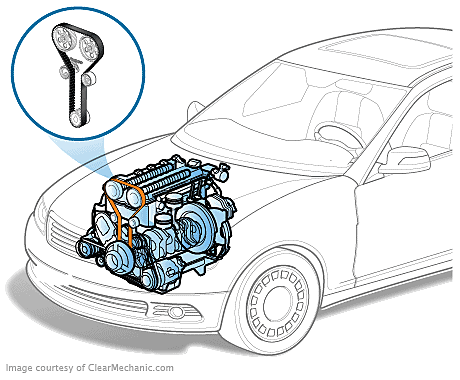Introduction
Have you ever considered the timing of your car’s engine elements as they dance in harmony? If not, then it’s time to introduce the maestro of this intricate orchestra: the timing belt.
What is a Timing Belt?
The timing belt, the unsung hero under the hood, synchronizes the rotation of your engine’s crankshaft and camshafts. This critical element ensures that your engine’s valves open and close at the correct times during each cylinder’s intake and exhaust strokes. Without it, your engine’s symphony would be more like a cacophony, leading to potentially severe engine damage.
How Much Will it Cost to Replace a Timing Belt in Canada?
Replacement of a timing belt in Canada will generally cost between $500 to $1000. This estimate includes parts which cost between $100-$200 and labour, which can range from $400 to $800. The process can be time-consuming, typically taking between 2 to 5 hours, depending on the vehicle and mechanic’s experience level.

What are the Symptoms of a Faulty Timing Belt?
Here are some common symptoms of a faulty timing belt:
• Engine Misfires: A worn-out timing belt might slip from the camshaft, leading to one of the cylinder heads to open and close prematurely. This can result in an engine misfire.
• Ticking Noise: A ticking noise coming from the engine is one of the most common symptoms that your timing belt is wearing out or has broken.
• Engine Won’t Turn Over: If the timing belt has broken, the engine might not start or it may cause severe damage when you attempt to start it.
• Oil Pressure Decline: If the timing belt has started to wear out, pieces of it might fall into the oil pan, leading to a decline in oil pressure.
• Excessive Exhaust Fumes: If the timing belt is wearing out, the engine’s combustion process may not function correctly, leading to more exhaust fumes than usual.
• Poor Engine Performance: If the timing belt is worn or stretched, it may slip and disturb the engine timing, causing poor performance, lower fuel efficiency, and in some cases, the engine might stall or not start at all.
How Long Does a Timing Belt Last?
Most manufacturers recommend replacing the timing belt every 96,000 to 160,000 kilometers, though it’s always wise to check your vehicle’s specific maintenance schedule.
How Does a Timing Belt Become Defective?
A timing belt can become defective due to several reasons:
• Age and Wear: Over time, the timing belt can simply wear out due to constant tension and heat exposure. This can lead to cracking, fraying, or stretching of the belt.
• Incorrect Tension: If the timing belt is too tight, it can put excessive stress on the bearings of the pulleys it runs on, causing them to fail prematurely. If it’s too loose, it might not grip the pulleys properly and slip, leading to inaccurate valve timing.
• Contaminants: Oil leaks or coolant leaks can contaminate the timing belt, causing it to degrade and fail prematurely. Rubber-based belts are particularly susceptible to damage from oil and coolant.
• Heat Exposure: Excessive heat from the engine can also cause the timing belt to become brittle and crack.
• Misalignment: If the pulleys are not aligned properly, they can cause uneven wear on the timing belt, leading to early failure.
• Manufacturing Defects: Although rare, manufacturing defects can also cause a timing belt to fail. This includes using inferior materials or improper construction methods.

How Can a Faulty Timing Belt Affect Other Systems in the Car?
• Engine Performance: A faulty timing belt can affect the performance of the engine. It can cause misfires, a loss of power, poor fuel economy, and even complete engine failure.
• Valve and Piston Operation: If the timing belt fails, it can lead to the pistons colliding with the engine’s valves. This can result in damage to the valves, cylinder heads, or the cylinder walls.
• Engine Damage: A broken timing belt can cause catastrophic damage to the engine. This is particularly true for interference engines, where the timing of the valves and pistons are closely linked.
• Oil Pressure: If the timing belt breaks and causes internal engine damage, it may result in a drop in oil pressure. This can lead to further engine damage if not addressed immediately.
• Electrical Systems: As the engine could suddenly stop due to a timing belt failure, the alternator will stop charging the battery, potentially affecting the electrical systems of the car.
• Emission System: Faulty timing belts can also impact the emission systems of the car, leading to increased emissions, as the engine may not burn fuel efficiently.
Is it Safe to Drive with a Faulty Timing Belt?
Driving with a faulty timing belt is extremely unsafe and not recommended at all. The timing belt is a crucial component of your engine, ensuring that the crankshaft and camshafts are synchronized properly. This synchronicity allows your engine’s valves to open and close at the correct times during each cylinder’s intake and exhaust strokes. If the timing belt fails or is faulty, it can cause severe engine damage, sometimes leading to a catastrophic engine failure. In many engines, a failed timing belt can lead to the pistons colliding with open valves causing bent valves, damaged cylinder heads, or even damage to the cylinder wall or piston itself.
Apart from the potential for significant engine damage, a failed timing belt also presents a serious safety risk. If the belt breaks while driving, it could cause your engine to suddenly stop running. Depending on your speed and surrounding traffic conditions, this could put you in a very dangerous situation – you might lose power steering and other essential functions, and you could end up stranded in a high-traffic area or even cause an accident. Therefore, if you suspect your timing belt may be faulty or due for a replacement, it’s important to have it checked out by a professional mechanic and replaced if necessary as soon as possible.
How Can I Make My Timing Belt Last Longer?
• Keep your engine well-maintained and free from oil or coolant leaks.
• Adhere to your vehicle’s specific maintenance schedule.
• Avoid extreme driving conditions, such as rapid acceleration and deceleration.

Can a Mobile Mechanic Replace a Timing Belt?
Certainly! Many mobile mechanics are fully equipped to handle a timing belt replacement at your convenience, whether at your home or workplace.
Conclusion: Timing Belt Replacement
Timing belt replacement is not a cheap affair, but neglecting it could result in an even more costly engine repair. Stay in tune with your car’s maintenance schedule and watch out for signs of a faulty timing belt to keep your vehicle’s engine performing harmoniously.
Next Steps
Book Your Timing Belt Replacement Service
The service most frequently booked by those who read this article is Timing Belt Replacement. Uchanics’ expert technicians make the process even more convenient by bringing the service right to your doorstep. We perform this job at your home or office, covering over 40 cities in Ontario, including Toronto, Mississauga, Brampton, Oshawa, Ajax, Scarborough, and more. With our professional expertise, we ensure accurate timing belt replacement to keep your engine running smoothly. Choose Uchanics for your Timing Belt Replacement and experience unparalleled convenience and top-quality service.
